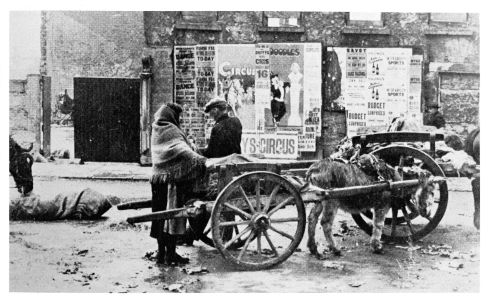Old Galway
BUTTERMILK LANE

by Tom Kenny
William Evans was a distinguished painter in the nineteenth century who did a very unusual and adventurous thing for an English artist at the time, he travelled widely in Conamara and West Mayo. We can only speculate what attracted him to this wild, rugged and remote terrain but he liked the parts of the country least visited, and said that “Ireland failed to attract the pencils of the recording brethren of the easel and lay like a virgin soil untouched by the plough”. He produced many studies and finished watercolours, a mixture of landscapes, streetscapes and market scenes and what might be called peasant structures and peasant portraits.
THE LOCAL SECURITY FORCE

by Tom Kenny
In the first years of the Second World War, the numbers of personnel in the army multiplied by between six and seven times. The Army began by calling up on permanent service part-time soldiers already in existence, ie, reserve and volunteer units. By early summer 1940, numbers had to double again. These new recruits had to be trained and this put a major strain on army resources.
SHOP STREET, 1903

by Tom Kenny
This was Shop Street, Galway’s main street, decorated for the visit of Edward VII in 1903. The poles along the footpath were especially erected to carry bunting and decorations and many buildings had their own flags and other forms of decoration. It was a big occasion in the city. The prince came into the station on the railway from Clifden, was taken by horse and carriage around the Square, through the streets and around by Raven Terrace and back to the Docks where his royal yacht was waiting.
GOING TO MARKET

by Tom Kenny
“Every Saturday morning a procession of donkey-carts set out, nose to tail, for the market in Galway. This took place in the triangular patch by the Collegiate Church of St. Nicholas. It dates from 1320 and was dedicated to St. Nicholas, the patron saint of sailors, who was chosen then as the patron saint of Galway. There the donkeys were unharnessed and tethered to a wheel, the shafts were let down to the ground and the goods to be sold were displayed on the sloping cart. Vendors came from many more prosperous areas and their wares were a source of envy to those who lived in the congested strip along the coast. Eggs in big wicker baskets with hinged lids, ducks, hens and chickens, wooden kegs of buttermilk, home churned butter laid in rolls on cabbage-leaves, cabbages, onions, sometimes geese, hand-knitted socks – all sold briskly throughout the morning to the people of the town.
THE SAVOY CINEMA

by Tom Kenny
In 1933, plans had been completed and passed by the Galway Urban District Council for a new cinema to be built on Eglinton Street by the famous baritone, Mr. Walter McNally. “The building will be beautiful and imposing, designed on the most up-to-date lines. The theatre will have seating for over 800 on the ground floor while the balcony will be capable of holding over 300”.
Middle Street, c1920

by Tom Kenny
Our photograph shows Olly Shea from High Street with his two cousins, the Brays from Father Griffin Road. They are standing in Middle Street which looks very wide with nothing parked there. The building on the far left was a tenement which later became a timber yard. Next door was a store which was owned by O’Gormans. The building beside that, with the white gable, was Tim Murphy’s; he ran a second-hand clothes shop there and carded wool. Next door was another tenement which was later taken over by Corbett’s timber yard.
Students rolling in money

by Tom Kenny
In 1961 a group of 11 students from UCG decided to roll a barrel from Galway to Dublin and to collect money for the relief of famine and suffering in the Congo on the way. They wanted to roll the barrel, but the bands fell off before they got to St Patrick’s Church, so they borrowed an old pram from someone.
THE CASTLE OF TÍR OILEÁIN

by Tom Kenny
The Library of Congress in Washington gave us this 1913 photograph of the ruins of the castle of Tír Oileáin, or Tirellan, sometimes wrongly referred to as Terryland, and now generally known as Oldcastle. It was strategically very important as it commanded the river at a point where there was a ford. It was a De Burgh castle.
.png)